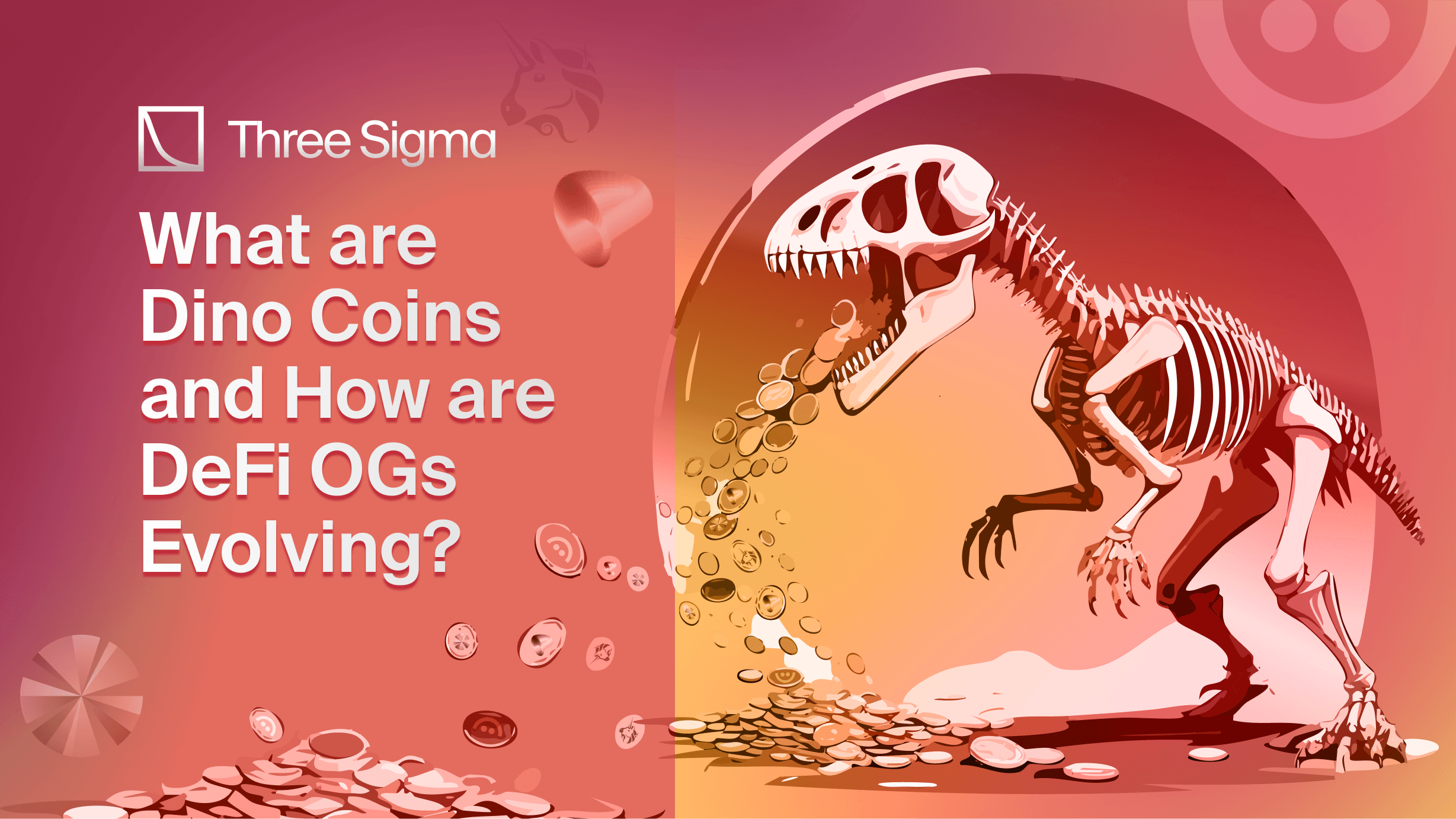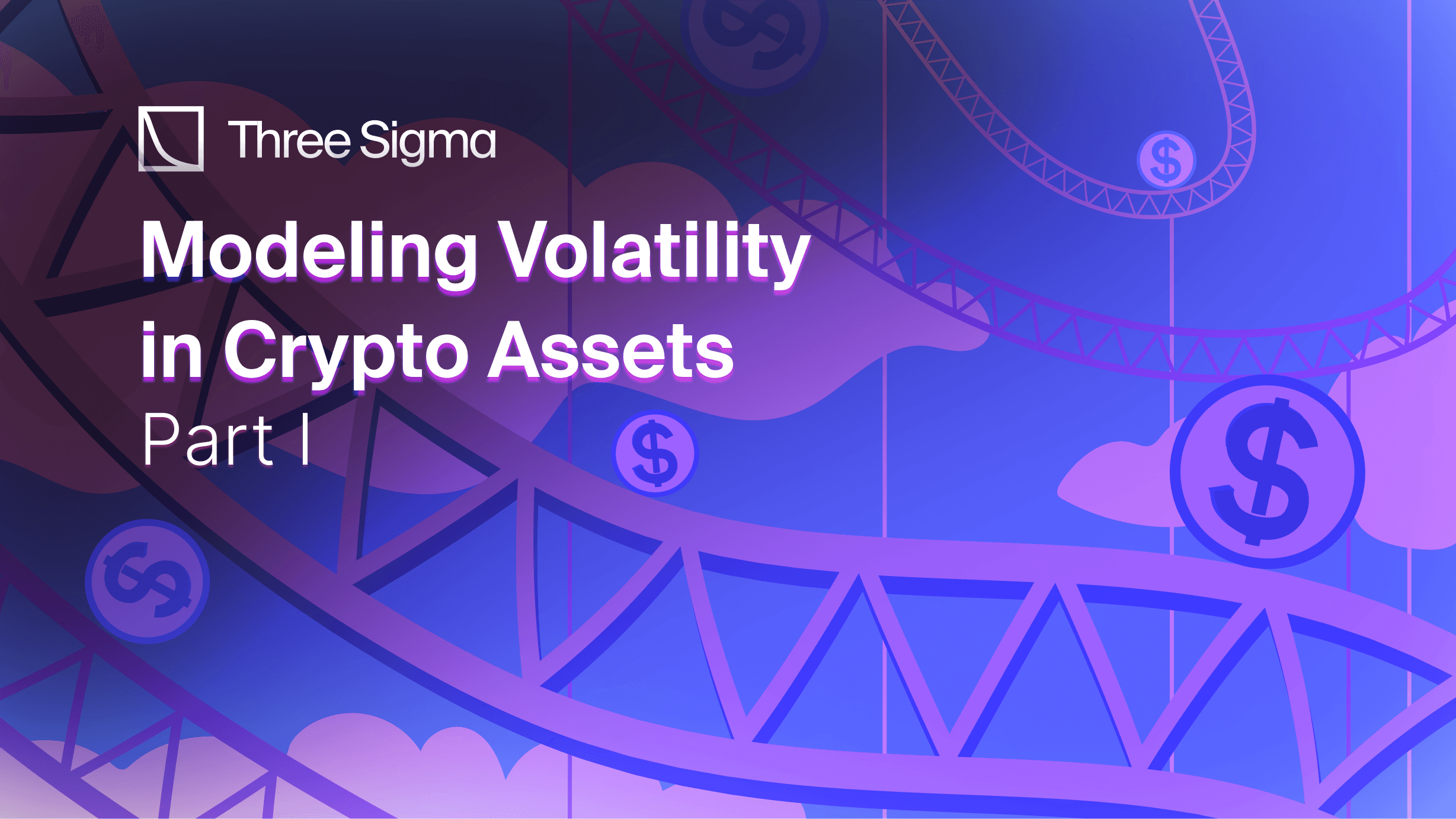Last year, we dove into the world of tokenomics, breaking down how different DeFi protocols use tokens to reward and engage their communities. Our goal was to create a clear framework that made it easier to understand and compare token mechanics across the entire DeFi ecosystem. Back then, we identified three main types of token reward mechanisms.

Holding: Simply keeping your tokens to earn rewards.Staking: Locking up your tokens for a set period to receive higher rewards.Locking: Committing your tokens for a fixed duration with even greater incentives.We also explored key incentive models like fee discounts, revenue sharing, and governance through vote-escrowed tokens. This approach helped us compare different DeFi protocols and understand the benefits of their token strategies.For this article, one of the focus points is to answer a simple question.What has changed?We will be focusing on a specific subset called DeFi’s Dino Coins: long-standing giants that have shaped the DeFi landscape.Dino coins include:
- MakerDAO ($MKR) @SkyEcosystem
- Aave ($AAVE) @aave
- Compound ($COMP) @compoundfinance
- Uniswap ($UNI) @Uniswap
- Curve ($CRV) @CurveFinance
- Synthetix ($SNX) @synthetix_io
- dYdX ($DYDX) @dYdX
- Chainlink ($LINK) @chainlink
Why Tokenomics matter?
Let’s begin by understanding what are Tokenomics. Tokenomics shapes the economic design of a protocol’s native token. It represents much more then solely supply distribution and token price, as it is also the key to determining how the token functions, circulates, and rewards its users.

Effective tokenomics are the backbone of any sustainable DeFi protocol.A hard truth to swallow is that a protocol's performance is closely linked to the success of its token, which heavily depends on its tokenomics. A well-crafted model ensures that stakeholders see value in holding or using the token, making them both financially and strategically invested in the protocol's growth.Among the primary characteristics that define tokenomics, these are some of the main ones:
- Supply & Demand Management — This aspect dictates how tokens are issued and controlled from the beginning of TGE, including strategies for token emissions, burns, and buybacks. This supply-side management directly influences token scarcity, demand, and, ultimately, token value.
- Distribution—This is specifically about the initial pre-defined allocation of tokens, which determines who holds and benefits from it. Tokens may be allocated to investors, the project team, community members, and to the ecosystem’s growth. Distribution seeks to align incentives among all stakeholders, however, supply control and other problems seen from past token distributions have been increasingly criticized recently, examplified by @MustStopMurad latest speech on VC tokens.
- Incentive Design: Defines how a protocol rewards its participants, encouraging active engagement and adding value to the ecosystem. This includes staking rewards, liquidity incentives, governance rights, and utility-based incentives like fee reductions or revenue-sharing models. Recently, points programs have emerged as a new paradigm for incentives in crypto. In these programs, a percentage of the token supply is allocated specifically for points-based rewards. Participants earn points through various activities, and later, during the TGE, these points are converted into a proportional percentage of tokens.

Applying the 3-Characteristics Tokenomics Framework to DeFi Pioneers: Compound and CurveTo demonstrate how the principles of tokenomics, including supply management, distribution strategies, and incentive design, are effectively employed, let's examine two DeFi Dino protocols: Compound and Curve, and analyze how these tokenomics characteristics have been implemented to drive the protocols' success.Compound: Pioneering Liquidity IncentivesCompound’s model focused on incentive design, using liquidity mining to distribute COMP tokens to lenders and borrowers.
- Incentive Design: Compound rewards users who supply or borrow assets from the protocol by distributing COMP tokens proportional to their share of the pool. Initially, 45% of the total COMP supply was allocated for liquidity mining, and currently, only 11% remains to be distributed.
- Dynamic Distribution Strategy: Daily Emissions: Approximately 1,789 COMP tokens are emitted per day, distributed across various markets within the protocol. Emissions are split evenly, with 50% allocated to suppliers and 50% to borrowers.
- Governance: Governance Rights: COMP holders can propose and vote on changes to the protocol, including interest rate models and asset listings, ensuring that active users have a say in the protocol's future. Proposal System: Any address delegated at least 1% of the total COMP supply, which currently amounts to roughly $4m worth of COMP, can submit governance proposals, directly influencing protocol parameters.
Curve: Introducing veToken MechanicsCurve's vote-escrowed token (veToken) mechanism emphasizes long-term commitment and active participation. Through veCRV, users are incentivized to lock CRV tokens for extended periods, gaining enhanced governance power and rewards.
- Incentive Design: Curve encourages users to lock CRV tokens for up to four years. In return, they receive veCRV, which amplifies governance rights and boosts liquidity mining rewards by up to 2.5x. This direct link between lock-up duration and benefits promotes longer-term alignment. CRV tokens are distributed over an extended period, with emissions decreasing by approximately 16% each year. The total supply of CRV is fixed at 3.03 billion tokens, with emissions continuing over 200 years, though significant distributions slow down after the early decades.
- Dynamic Distribution Strategy: Users lock their CRV tokens, reducing the circulating supply and receiving veCRV in proportion to the amount locked and duration. The veCRV system allows users to enhance their liquidity mining rewards, incentivizing greater participation and longer lock-up periods. veCRV is non-transferable, implying it can not be directly sold on the market.
- Governance: Governance Rights: veCRV holders actively participate in governance decisions, including directing CRV emissions to liquidity pools. veCRV holders receive a portion of the trading fees generated on the platform. Proposal Sytem: veCRV holders can submit and vote on proposals that influence Curve’s future. This includes adjusting CRV emissions, amending liquidity pool parameters, or making strategic protocol changes. Voting power is weighted by the amount of veCRV held, aligning governance influence with the level of long-term commitment. The proposal process is highly community-driven, with veCRV holders having direct influence over key decisions. This system also empowers users to channel rewards and incentives to pools they deem valuable, shaping the platform's liquidity allocation in real-time. Check CRV governance here.
While both Compound and Curve effectively use tokenomics to drive protocol success, they differ significantly in their approach:
- Compound incentivizes active use of the platform through liquidity mining and shared governance, aiming to maximize liquidity and utilization. Compound's governance is accessible with the native COMP token, and proposals require at least 400,000 votes to pass. Additionally, COMP tokens are distributed through daily emissions until max supply is reached.
- Curve’s governance requires users to lock CRV to obtain veCRV, a locked version of the token that not only grants voting power but also allows holders to boost their rewards in the protocol’s liquidity pools. Unlike Compound, Curve does not rely on emissions in the same way; instead, it rewards veCRV holders with boosted yields on liquidity pools.
Overall, the differences show that Compound focuses on platform usage and flexible governance participation, while Curve emphasizes long-term alignment and deeper commitment to the protocol through locked voting power and reward-boosting benefits for veCRV holders.
Has there been any fundamental change?
Looking at these industry giants, we ask, has there been evolution over the past year? The short answer is yes, yet we’ll give a full explanation on what’s happening.Amongst the DeFi dino coins we are covering, we’ve seen innovation, yet much of it reinforces their already established models rather than introducing brand-new tokenomics models. This evolution seems intentional, as drastic changes could risk shifting the community’s perception of the protocol/token.While core principles remain, new mechanics have emerged to boost value capture and governance, pushing the boundaries of what these models can achieve.
Below, you can see some of the things that are changing in the protocols tokenomics since last year: MakerDAO@MakerDAO is currently revising its tokenomics as part of its Endgame Plan. Historically, the protocol used a buyback-and-burn model for its MKR token, where surplus revenues were used to repurchase and burn MKR.This model shifted to a so-called buyback-and-liquidity provision model. Instead of burning MKR, the protocol now buys back MKR and pairs it with DAI on Uniswap to provide liquidity.

With the introduction of SKY, MKR holders gained the option to wrap their tokens into SKY. This change made the MKR/SKY system inflationary, introducing annual emissions as SKY rewards are distributed to participants. This mechanism remains a policy but has been paused due to insufficient surplus funds, largely because of resources being redirected.Currently, MakerDAO's tokenomics are in a state of flux. There are upcoming votes to potentially migrate from SKYback to MKR, which could simplify the tokenomics and address inflationary concerns.Another ongoing voting is to move MKR/SKY back to a deflationary model, potentially reinstating the buyback-and-burn approach. These proposed changes aim to realign incentives for token holders, promote long-term protocol growth, and stabilize the value of MKR.Aave@AaveAave introduced significant updates to its tokenomics model. Historically, AAVE stakers earned inflationary yields by depositing their tokens into the Safety Module, which acted as last-resort capital in case of shortfalls. Through the recent proposal by the Aave Chan Initiative (ACI), the Safety Module will be phased out in favor of a revenue-sharing model.Instead of issuing new tokens as rewards—which leads to inflation—Aave plans to use a portion of its protocol revenue to buy back AAVE tokens from the market. These purchased tokens will then be distributed to users who stake stablecoins and select assets on the supply side.By eliminating the Safety Module, estimated to happen before EOY2024, AAVE holders will reduce their risk exposure, as they are no longer the primary backstop for bad debt. Stakers now receive rewards aligned with the protocol's profitability, aligning their interests more closely with Aave's financial success.The Safety module has roughly $400m worth of AAVE staked.

The proposal outlines potential changes, including automated slashing, replacing stkAAVE and stkABPT with aToken staking, and introducing new incentive designs—all subject to community approval.Following the announcement of these proposed tokenomics updates, the price of AAVE surged by 50% in one month, showcasing the community's excitement.CompoundThe @compoundfinance protocol's COMP token primarily served as a governance token, allowing holders to propose and vote on changes within the protocol. COMP tokens were distributed to users as incentives for supplying or borrowing assets, aiming to increase participation and decentralize token ownership, at the expense of diluting the holdings of existing stakeholders.

A recent governance proposal to enhance the utility of the COMP token by implementing a staking mechanism. This proposal suggests the creation of a staked COMP (stCOMP) token, allowing COMP holders to stake their tokens in exchange for a share of the protocol's fee revenue. The primary objectives are to reward long-term holders, reduce token sales pressure, and increase engagement in governance activities.If implemented, this proposal would mark a significant evolution in Compound's tokenomics, shifting from a purely governance-oriented model to one that includes economic incentives for token holders. This adjustment aims to enhance the token's utility, providing stronger incentives for new users and investors to purchase COMP while also rewarding and retaining long-term holders.UniswapThe UNI token was and is primarily serving governance functions. The introduction of Uniswap V4 and Uniswap X were some of the notable developments this past year.The improvement of tokenomics is a focus topic for Uniswap.First of a proposal to turn the "fee switch" was introduced, aiming to activate Uniswap's protocol governance to enable the collection of protocol fees and distribute them to UNI token holders who have staked and delegated their tokens. However, this proposal did not pass, as major UNI holders voiced regulatory concerns.The activation of this fee switch could be detrimental to Uniswap's volume. Gauntlet conducted an analysis, as shown in the chart, estimating potential volume loss due to protocol fees.

With Unichain, Uniswap's new Layer 2, UNI's utility will be enhanced, enabling staking as a requirement for validators in the Uniswap Validator Network (UVN). Validators must stake UNI on Ethereum mainnet, with staked balances tracked on Unichain. At the start of each epoch, staked balances are snapshotted, blockchain fees are collected, and rewards are calculated per staked UNI. Participants can increase a validator’s stake-weight by staking UNI, and only those with the highest stake-weight form the active set, eligible to earn rewards for the epoch.Some additional governance proposals have been:
- Uniswap Delegate Reward Initiative - Cycle 2: This program rewards top Uniswap delegates for active participation, encouraging them to maintain 80% voting engagement. Delegates who contribute additional efforts are eligible for up to $6,000 in monthly UNI rewards. Link.
- Mobilizing the Uniswap Treasury: Aimed at diversifying and better utilizing the $6B treasury (mostly in UNI), this proposal formed the Uniswap Treasury Working Group to research strategies for stability and growth. Link.
Curve@CurveFinance has no plans on changing its veToken model. Locking CRV to grant veCRV holders governance power and higher rewards for providing liquidity. This mechanism deepens liquidity commitment while stabilizing token supply. The CRV inflation rate has been reduced over time, now reaching 375 CRV per block, which is half of the initial inflation rate.Curve continues to expand its ecosystem through governance proposals that allow the community to add or adjust assets within the protocol. These proposals enable users to vote on whether to add new liquidity pools or “delist” abandoned or hacked stablecoins, directly impacting the distribution of gauge weights and CRV rewards. Link.SynthetixThe SNX token primarily supported @synthetix_io synthetic asset ecosystem through staking, governance, and incentive distribution. Over time, the protocol’s tokenomics evolved to better align SNX’s utility with Synthetix’s goals, though some challenges persisted in terms of decentralization and SNX’s role within the ecosystem.Entering 2024, Synthetix initiated an overhaul of its tokenomics with a governance consolidation under the new SR-2.In SR-2, the proposed changes to SNX tokenomics focus on re-centralizing the SNX token within the Synthetix ecosystem, aiming to make it more integral to both governance and the protocol’s overall functionality. Key elements of SR-2 include:
- SNX Token Redesign: SR-2 proposes a redesign of the SNX token to re-establish it as a core component of Synthetix. This may involve modified staking mechanisms, new reward structures, or enhancements to its utility, positioning SNX as more integral to protocol operations and governance.
- Council Stipend Adjustments: To improve efficiency, SR-2 suggests reducing council stipends by approximately 20,000 SNX per month, and reallocating these savings to other incentives and initiatives. This cost adjustment is intended to sustain resource availability and strengthen SNX’s use case in the protocol.
- SnaXchain Framework: SR-2 introduces SnaXchain, a framework to operationalize SNX through potential new functionalities like staking or burning mechanisms, which would deepen SNX’s integration into protocol processes.
Synthetix also recently proposed acquiring Kwenta to relaunch Synthetix Exchange under a unified brand. The acquisition involves a token-for-token swap and a controlled minting of new SNX tokens, representing a minor inflation of 2.8% to fund the transaction.ChainlinkIn 2023, Chainlink's LINK token primarily functioned as a utility token, facilitating payments for oracle services and serving as a staking asset to enhance network security. The tokenomics were centered around incentivizing node operators and securing the network through staking mechanisms.In 2024, @chainlink introduced significant changes under the Economics 2.0 framework, aiming to create a more sustainable and secure ecosystem. Key developments include:
- Chainlink Staking v0.2: Building upon the initial v0.1 release, Staking v0.2 launched in November 2023 with an expanded pool size of 45 million LINK, representing an 80% increase from v0.1. This version introduced a modular architecture for future upgrades, a new unbonding mechanism for withdrawals, and the ability to slash staked LINK from node operators to enhance security guarantees. Community stakers can earn a base floor reward rate of 4.5% per year in LINK for helping secure the network. More details can be found here: https://blog.chain.link/chainlink-staking-v0-2-overview/
- Transition to Fee-Based Rewards: Chainlink is shifting from issuing new tokens for rewards to a model where fees paid by users for oracle services fund node operators and stakers. This approach promotes a sustainable, self-sufficient economy by distributing fees paid in LINK among node operators, stakers, and the protocol. Details on this model are available at: https://blog.chain.link/sustainable-oracle-economics/

The visual summary below helps illustrating the token models (veToken, staking, buybacks) alongside value accrual mechanisms like revenue sharing, emissions, or governance. This reveals how each of the protocol talked about adapts its tokenomics to sustain and grow its ecosystem.

New DeFi Kids in the Block
While DeFi may seem stagnant, a wave of innovation has been unfolding. Not only has the tech advanced, with new sectors like restaking emerging, but some protocols are also challenging old assumptions about tokenomics and value accrual. Some projects are leveraging well-established models, while others are rethinking fundamental aspects of how tokens function, incentivize, and accrue value within their ecosystems. Let’s explore what sets these new contenders apart.
- Ethena ($ENA) @ethena_labs
- Pendle ($PENDLE)@pendle_fi
- Pyth Network ($PYTH) @PythNetwork
- Jupiter ($JUP) @JupiterExchange
- Ether.fi ($ETHFI) @CurveFinance
- Jito ($JTO) @jito_sol
Ethena (ENA)ENA is, first and foremost, a governance token, overseeing the Ethena protocol and its critical decisions. ENA token holders can vote biannually to elect members to essential governance committees, such as the Risk Committee. Governance is active, with the community voting on initiatives like Ethereal (a perpetual DEX on Ethena) and other strategic decisions.Staked ENA (sENA) serves as the liquid staking token (LST) to earn rewards, including unclaimed ENA from the Season 2 airdrop. sENA holders have additional governance privileges, directly voting on tokenomics proposals and ENA-specific proposals. Additionally, 15% of Ethereal’s future token supply is reserved for sENA holders, promoting the overall utility of ENA.In a recent partnership with Symbiotic, Ethena added restaked ENA functionalities, providing security for cross-chain transfers of USDe through LayerZero’s messaging system.
- Supply & Demand Management: Ethena operates with a fixed supply of 15 billion ENA tokens. Value accrual is promoted through structured vesting conditions rather than supply adjustments. For instance, users receiving ENA through initiatives like the Points Campaign are required to lock a portion of their tokens using designated methods (e.g., Ethena locking or PT-ENA on Pendle).
- Incentive Campaigns: Ethena approaches to value accrual and incentives through its structured, multi-phased reward system. Season 1: Ethena’s Shard campaign launched as a unique reward system for early participants, focusing on active engagement rather than a typical points model. Shards were earned by providing liquidity in key Curve pools for USDe. Participants could lock their LP tokens with Ethena to accumulate shards, which gradually decreased in reward rate as the campaign progressed, incentivizing early participation. At the Token Generation Event (TGE), these shards could be converted to ENA tokens. Season 2: Introduced Sats as rewards, integrating Bitcoin as a backing asset. Users earn Sats by participating in similar activities, which later convert into ENA tokens. Season 3: In Season 3, Ethena continues to incentivize user engagement with simplified, multiplier-based rewards. USDe holdings in selected DeFi applications, such as Morpho, Aave, and Curve, earn up to 30x rewards depending on maturity length. sENA becomes a core asset for point accumulation too.
Pendle (PENDLE)
- Supply & Demand Management: As of September 2024, all team and investor tokens have fully vested, with the circulating supply increasing solely through incentives and ecosystem development. Pendle has a weekly emission of 216,076 PENDLE tokens, decreasing by 1.1% each week until April 2026. After that, it will adopt a terminal inflation rate of 2% per annum to continue supporting incentives.
- Distribution: The circulating supply includes all freely circulating PENDLE tokens but excludes those locked in vePENDLE contracts, as well as tokens held in the Ecosystem Fund, Governance, and Team addresses.
- Incentive Design: Pendle employs the vote-escrowed PENDLE (vePENDLE) system where users can lock their PENDLE tokens for up to 2 years to receive vePENDLE, with the amount received proportional to the amount locked + duration. Holding vePENDLE offers several benefits such as voting, receiving 90% of the swap fees from the pools they vote for, and boosted rewards.

Pyth (PYTH)Pyth Governance (via PYTH) can help determine high-level parameters of the other network mechanisms. The governance is expected to be responsible for decisions such as determining the size of update fees, rewards, and approving other software updates.
- Supply & Demand Management: Pyth has a maximum supply of 10 billion tokens, with an initial circulating supply of 15% of the total supply. The remaining 85% is vested, with token unlocks in stages at 6, 18, 30, and 42 months after the initial token launch. As of October 6th, 36% of the supply has been unlocked.
- Distribution: Over 50% of the total supply is destined to ecosystem growth.
- Incentive Design: Pyth employs a range of strategies to encourage participation across its ecosystem. The protocol fosters its ecosystem by rewarding all users: data providers for accurate and timely contributions, incentivizing ecosystem growth with grants for developers and educators, and empowering PYTH token holders with governance rights to influence protocol decisions like update fees and reward structures.

Jupiter (JUP)Supply & Demand Management:
- JUP has a total supply of 10 billion tokens. A proposal has already been made to reduce the total supply by 30%, aiming to address concerns about high FDV and token emissions. At launch, the initial maximum circulating supply was 1.35 billion JUP tokens, including allocations for the community airdrop, liquidity provision, and other immediate needs.
Distribution:
- The total supply of 10 billion JUP is split evenly between the team and the community, with 5 billion JUP allocated to team members and 5 billion JUP designated for the community through annual airdrops and grants managed by the Jupiter DAO.
Incentive Design:
- Governance Participation: JUP tokens are designed to govern the upcoming Jupiter DAO. The JUP token is alsoo not initially designed with utility features beyond governance., and the team has previously emphatized that utility is not the primary driver of the token's value at this stage.

Ether.fi (ETHFI)
- Supply & Demand Management: Ether.fi has established a fixed total supply of 1 billion ETHFI tokens, with no plans for any further issuance. The initial circulating supply consisted 11.52% of the total supply. Token distribution was structured through two airdrop seasons:Season 1 Airdrop distributes 6% of the total supply. Any tokens unclaimed during this season will roll over into Season 2. Season 2 Airdrop is planned to distribute 5% of the total supply, with specific dates to be announced.
- Distribution: The distribution of ETHFI has 11% allocated via airdrops to early and active community members. Tokens are also allocated with vesting schedules to the team and contributor. 27% of the tokens are reserved for the DAO treasury, which helps with the ecosystem growth. A portion of protocol rewards goes back to the DAO treasury, governed by ETHFI holders, ensuring a continuous distribution of rewards to sustain the ecosystem’s growth.
- Incentives Design: Eligibility for the airdrop included early adopters and NFT holders, solo stakers, holders of eETH or weETH, participants in eETH or weETH DeFi pools or vaults, and other participants. Holders of ETHFI tokens gain the ability to participate in governance, influencing in decisions such as setting fees, approving upgrades, allocating grants, and managing the treasury. Additionally, holding ETHFI enhances a user's StakeRank, potentially unlocking further benefits within the protocol. Users can also stake their ETHFI into vaults to automatically restake those tokens on Karak, earning points for Karak airdrop and Ether.fi points tokens to earn extra incentives, including opportunities like running an Ethereum node.

Jito (JTO)
- Supply & Demand Management: Jito has a fixed supply of 1 billion JTO tokens. The circulating supply is initially distributed via targeted airdrops and community initiatives. 10% of JTO tokens were allocated to the Jito community through an initial airdrop, and similarly to pyth, approximately 50**%** of tokens were directed toward ecosystem growth.
- Governance Participation: JTO holders gain governance rights over several critical aspects, such as setting JitoSOL staking fees, managing treasury allocations, and determining delegation strategies.
- Incentive Design: Incentives are designed to reward contributions from validators and active participants in the Jito Network. JTO holders get a slice of the MEV pie and get to enjoy additional gains captured by the Jito Block Engine. JitoSOL users, validators running the Jito-Solana MEV client, and searchers who utilize Jito's MEV products are prioritized in token distribution. Tokens allocated to core contributors and investors are vested over 3 years with a 1-year cliff.

While we look at these protocols and understand how their tech is necessary for the next evolution of blockchain, not many are bringing real innovations in their token models.Most new protocols prefer basic approaches, either having tokens without mechanics or adding simple staking/locking mechanisms for it. Point programs have become a common incentive among these newer protocols, with a major amount actually having a point system, while the 'OGs' had to go through a TGE focused on traditional airdrop methods. Some protocols, such as Pyth and Jito, demonstrated different distributions than usual, allocating as much as 50% exclusively to ecosystem growth.
Major Trends in Tokenomics and Governance

Throughout 2021, projects like Ethereum and Binance Smart Chain witnessed explosive growth in DeFi applications, which was largely driven by innovative tokenomics. However, as the initial hype subsided, many tokens saw a decline in value and utility.By the next years, the narrative began to shift. The introduction of new token models focusing on real yield, governance, and revenue-sharing helped reignite interest. However, despite the market heating up again and reaching new highs, DeFi is still lagging behind its TVL from two years ago.This underperformance can largely be attributed to the stagnation of the core driver of DeFi, Ethereum, which has resulted in low enthusiasm for ETH-betas and slowed the sector’s growth.DeFi’s TVL today is largely composed of ETH, staked ETH (LSTs or LRTs), and stablecoins, meaning it heavily depends on ETH’s price movements. Without substantial growth in ETH’s value, TVL won’t expand. Specific DeFi sectors, such as DEXs, have faced challenges, further showcasing under-performance.However, not all sectors are underperforming (in terms of TVL). Certain areas, including liquid staking and lending, show strong resilience. Protocols like Aave and Lido are seeing positive TVL inflows and are nearing all-time highs, indicating that people, rather than using ETH for swaps on AMMs, prefer securing it in lending and staking activities to earn yield from ETH during its stagnant period.Additionally, the explosion of memecoins, which significantly diverges from the traditional DeFi venture capital model that has long been tiring the community, has introduced new ideas for what is governance and how simple tokenomics can be.

This shift has been particularly amplified by several key industry factors: the massive over-production of tokens has paradoxically made simpler memecoin models more appealing, while extremely inflated altcoin valuations at major exchange listings have pushed retail investors toward more grassroots options. Fair launches, while not always as fair as the name says, have become popular among a vast majority of users, with a distribution process that is much more decentralized and promotes broader community participation. The concentration of traditional token appreciation in private rounds, combined with consistently poor performance of 2024 token launches on major exchanges, has created a vacuum that memecoins are filling.Not everything is lost for DeFi tokens, though. Across both established protocols and new entrants in DeFi, several key trends are emerging that positively shape the tokenomics landscape:
- Emphasis on Long-Term Incentives: Both OG and newer projects are increasingly adopting staking and locking mechanisms to reward long-term commitment. Curve’s veToken model and Pendle’s vePENDLE system exemplify the focus. Additionally, new incentive mechanisms, such as point systems, have been evolving rapidly. Many newcomers are now developing phased point programs with fair distributions as a way to sustain engagement over time.
- Governance and Flexibility: Both established ("OG") and newer projects recognize the importance of improving governance by simplifying models or implementing dual-token systems. For example, Uniswap's fee switch empowers staked UNI holders, and newcomers like Ether.fi and Jito also ties governance power directly to protocol contributions like staking and validating.
Yes, things are advancing.However, while these shared trends indicate progress, there’s a persistent lack of originality going on.DeFi is at a crossroads. On one hand, the rise of memecoins has created cult-like followings that attract mainstream attention but offer little substance. On the other hand, innovation in DeFi appears stagnant, with teams replicating the same mechanics across different chains, diluting the originality that once defined the space. Innovation is often underappreciated by a large part of the user base, as negative sentiment about DeFi’s state makes newcomers feel their product must be strong enough to compete with established protocols.Complex mechanisms and convoluted governance models have overshadowed simpler, more transparent approaches that drew early adopters to the idea of a truly decentralized ecosystem. Perhaps it's time to go back to basics: crafting straightforward, efficient protocols that are easy to understand and rallying around a clear mission.Believe in something. To reclaim its soul, DeFi needs to refocus on simplicity and clear missions.Whether it’s the ethos of decentralization or financial inclusion, is what initially gave DeFi its soul. As new protocols emerge, it’s crucial to focus on purposeful design and to reinvigorate a sense of genuine community—a culture that values simplicity, accessibility, and integrity over endless clones and over-engineered models.This moment calls for more than technical ingenuity; it calls for rekindling a vision that people can believe in and rally behind while still contributing positively to the evolution of the ecosystem.
Dino coins aren’t dead they’re just overdue for reinvention. Our DeFi Ecosystem Strategic RD service helps OG protocols and new teams modernize tokenomics, governance, and utility for today’s markets.
Conclusions — Price Leads Fundamentals
In this article, we explored how foundational DeFi protocols like MakerDAO, Aave, and Compound have adapted their tokenomics to fit the new DeFi landscape. We also discussed the newcomers reshaping the landscape with fresh models and examined trends in DeFi governance.We highlighted the ongoing tension between innovation and simplicity and drew a line between market forces and token success.The dynamics between DeFi protocols and market performance reveal a critical insight: price often dictates perception more than fundamentals do. Protocols on Ethereum have suffered from the underperformance of ETH, partly due to a lack of interest in seeking for ETH exposure, all while minimal rotations into DeFi is happening.In contrast, Solana’s recent outperformance tells a different story, one driven more by cultural sentiment than purely by technical depth. Often perceived as a “memecoin chain,” Solana’s rise reflects a market pivot where cultural relevance can sometimes eclipse the intricacies of tokenomics.Moreover, regarding cultural sentiment, the crypto market has been increasingly focused on the new vision brought by the memecoin cycle, with tokenomics becoming less relevant and users accepting models that completely contradict the complex tokenomic models of traditional DeFi protocols. To learn more about the memecoin cycle, read here.We’ve seen this cycle before. No matter how refined a protocol’s tokenomics, launching during a market downturn risks failure. Without momentum, even the most sophisticated models can bleed value. It’s a crucial reminder that token price ≠ protocol health. The token’s success is not always a proxy for the protocol’s utility or innovation; rather, market relevance and cultural timing are as vital as technical design.The DeFi space is maturing, but the lessons remain the same: innovation is necessary, but timing and cultural connection are also paramount. Understanding the market’s mood, and building relevance by understanding that market, may be just as important as technical mastery.

Economic Security Lead
Pablo holds a Master's in management, having focused in finance, and with a thesis on DeFi, demonstrating his knowledge and expertise in this field. He has extensive experience in research and analysis of DeFi protocols, having worked as an analyst at Siemens and a DeFi researcher at Deep Tech Ventures. His background in finance, research and analysis skills are a valuable addition to our team.






